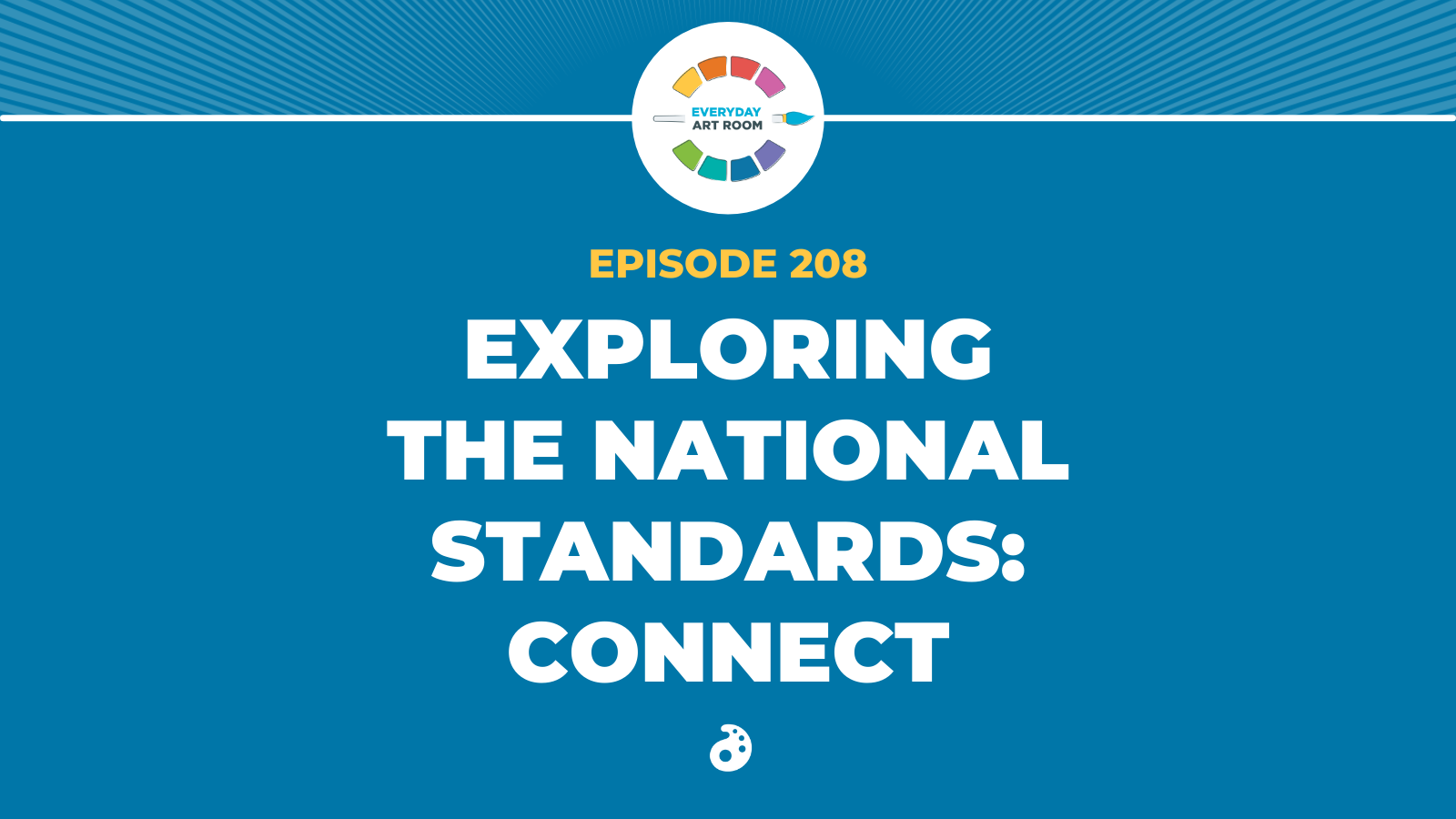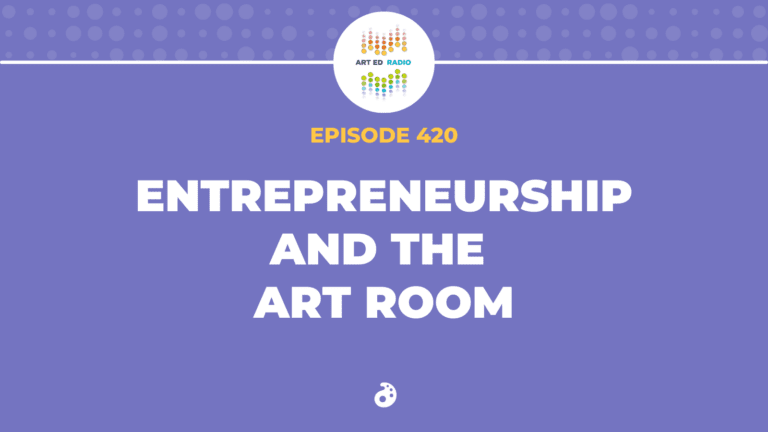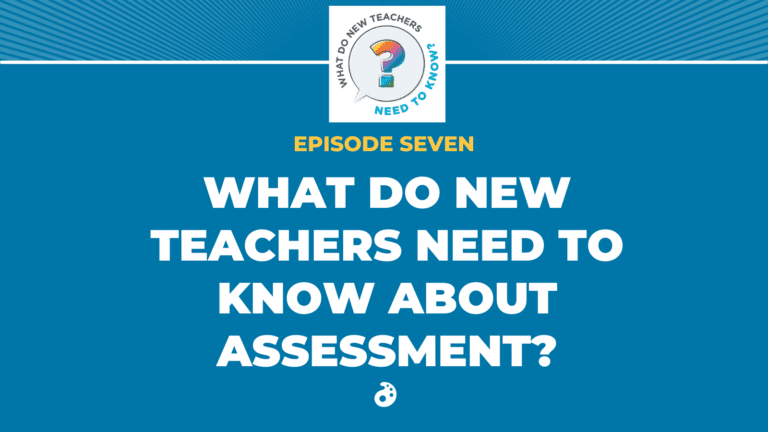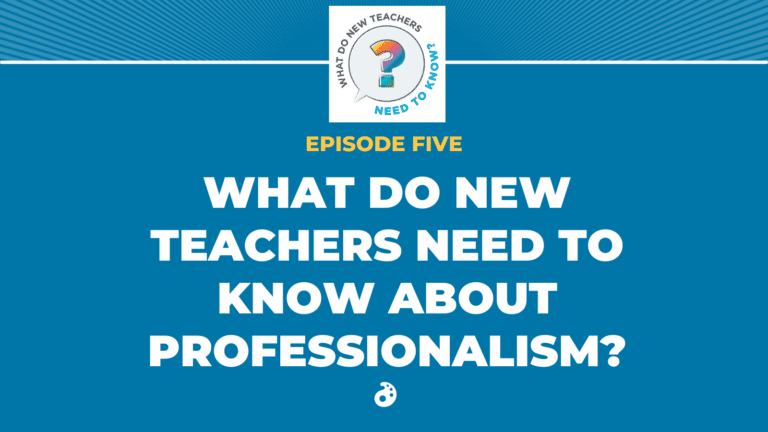This is the third episode in a series of Everyday Art Room podcasts that explore the national standards. Today, Nic gets a variety of voices to come on the show to talk about the Connect standard. Listen as they discuss how students can meet the Connect standard, why we should be utilizing personal experiences, and the importance of voice and choice. Full Episode Transcript Below.
Resources and Links
- Follow Ann, Corbie, Renee, and Michelle on Instagram
- View the NCCAS Conceptual Framework
- NCAS Visual Art Standards At-A-Glance
- View the PRO Learning Pack on Implementing the National Standards

Transcript
Nic: Today, we’re continuing our conversation about the national standards for our educators. I’m going to preface this by saying you might want to go back and listen to a couple of these podcasts previously if you have not. Two weeks ago, we talked to Janet Taylor who kind of laid the scene for us for the national standards. Then last week we had two guests join us who gave us ideas about how to incorporate the idea of respond into your classroom. And it was both in our elementary classroom, as well as our high school classroom. And then I gave a few ideas of how to respond with your middle schoolers. Today we’re going to take a shift and talk about another core value or core strand of our national standards, which is the word connect. We’re going to really focus on the word connect on Everyday Art Room. I’m your host, Nic Hahn.
Ann: Hi, my name is Ann Canida, and this is my 10th year teaching kindergarten through sixth grade art at Central Lee Community School District in Donnellson, Iowa.
Nic: That’s a little introduction on an Ann. Ann is the reason we’re doing this whole entire series. Ann reached out to me a couple of weeks ago, maybe even a couple of months ago, as of now, to just kind of pick my brain as a art educator and asked me, “What do you do to address the national standards in your classroom?” And I thought, man, that is a great, great question, but not one that I can just answer in an Instagram post or response. So I decided that we would dig a lot deeper. I asked Ann to give us a little bit more of an idea of what she’s looking for when she was thinking this question, how do I address the national standards? We last week had her ask about respond. This week she wants to ask us about how to connect. How are we supposed to encourage our students to connect?
Ann: Connecting. Is that connecting to styles? Is it connecting to cultures, historic artists, current contemporary artists? Is it all of those things? Is it one over the other or one in place of the other, depending upon the lesson or the project that you’re doing?
Nic: Again, I addressed this the same way as I did previously and I put this in a poll out there for art educators to respond to. I said, “Do you address the idea of connecting in your classroom?” And I had about a hundred people respond. 52 people said yes and 46 people said no. Again, we’re like split in the middle. So I think beyond why, we need to ask what are the circumstances of all of these? Of course, this is just a little snapshot, a 24-hour request out there on Instagram. So this isn’t scientific. I did not do proper research, but it’s quick research and it gives us a little bit of a starting point. There is about half of the educators that say, “Yes, I connect. I concentrate on the idea of connecting in my classroom, addressing the national standards.” And another half of the people are saying no. Perhaps they don’t have time. Perhaps it just doesn’t fit in. Perhaps they don’t know what this means.
If it is the latter, if you just don’t know what connecting means, let’s ask some of our peers. That’s again, what I did. I looked through the yes votes and I said, “Can you tell us what we did? What did you do to connect in your classroom to address this idea of connecting?”
I have three volunteers who have shared their voice with us today. We will get started with Renee. Let’s listen to what Renee has to say, how she connects in her classroom.
Renee: Hi, my name is Renee Lanham and I teach our at Central Plains Elementary School in Kansas. And I’m going to address how to use the National Arts Standard, connect. One of our goals as art teachers should be to get students to think critically about the art and have them make connections about the art. It is important to introduce students to a variety of artists like from different cultures and backgrounds, contemporary artists, as well as the old masters. I often show a PowerPoint to my students of an artist’s artwork and then we talk about the art. Then we do art projects based on the artwork.
A good way to have students connect with art is to have them predict what the figures in a painting maybe saying to each other or what they’re thinking and explain what is going on in the piece. Let them ask questions about the art even if you can’t answer them. We want them to be curious and be creative with their ideas. Sometimes my students make observations about the art that I had not even noticed.
You can use formative assessments as a way for students to connect with each other and to connect to the artwork more. Like in-progress critiques, peer-review thumbnail sketches, collaborating on a MURAL, are all good ways to include formative assessments. I hope this gives you some ideas of how to use the connecting part of National Art Core Standards.
Nic: Oh, Renee had such a good idea there. How fun is it to have kids actually predict what is being said in a piece of artwork? That’s really a really clever way to have students connect to a piece of artwork. I wonder if you handed your students a bunch of pieces of artwork and just put some speech bubbles in there, what would they put in for the words? Now this could definitely be any young artists that can write. Of course, they would need their writing skills, but I suppose we could do it with younger students just using their verbals. So what a clever way to do that? I think with the older kids, I’ve seen a similar idea happening with memes. Having students grab a piece of artwork and putting a meme with it. So, that is a really good idea from Renee.
We’re going to move on to another person who responded. Her name is Michelle, and she has some ideas of how she addresses connect in her classroom as well.
Michelle: Hey, everyone, it’s Michelle Parven from Brown Elementary School in Natick, Mass. I teach K through four and I’m happy to take a few minutes to talk to you about the national standard of connection.
One of the things that is sort of the driving force of everything I do is enduring understanding. And we have modified enduring understanding for elementary as follows: That artists tell stories, artists are problem solvers, artists explore and experiment, artists help others understand and appreciate the world around them, and artists build connections and community which ties right into the National Standard of Connections.
The way I see connections in all I do is sort of twofold, the societal, cultural, and historical context, and then the personal experiences or personal narratives. So starting with context is always a great place to start for my students. I use a lot of art history in my teaching. So we look at art, we talk about art, how does it make us feel? What do we think is going on? What do we see? What do we think the artist was trying to say? I use a lot of children’s literature in my art. Sometimes I even use videos to just provide that kind of community context.
We are also the magnet school in my district for English language learners. So I have a very diverse student population and using a lot of different projects from cultures around the world is great for my students because they see themselves in some of the things that are doing and they get really excited about that. “Hey, that’s me.” Or, “I know about that.” That also helps to build connections.
And then we have our school community. I try and do one to two collaborative projects every year that involve our entire school population, so students and staff. The most recent one that I did was a narrative sneaker project inspired by the work of Bisa Butler, where everyone in our building received a blank sneaker that I had drawn and made 500 copies of. And then they were asked: “If someone were to find your shoe, how would they know it was yours just by looking at it?” That was the only direction I gave and everyone kind of came up with their own personal narrative, but putting those all together on our various displays and [inaudible 00:09:59] boards around the school really is very impactful and it really brought our community together.
Another way that we build connections and community is in our town community at large. So we do have school-wide art show. We have a district-wide art show. And then I also, with my colleagues, started an art show at our senior center to kind of connect our oldest residents with our youngest residents, our elementary students, where we hang works of art of the elementary students and we have a little art reception at the senior center where everyone is welcome. So that is another way to create those connections through community.
And then of course there’s personal experiences. As artists, we want to do what we know, draw and paint and express ourselves in what we know just like writers do. And some ways to make connections through personal experiences, of course the most obvious is through self-portraiture. So one of the things that I do in my classroom is I scaffold the learning. For example, all of my students, K through four, would be working on self-portraits or portraits at the same time. But with my littlest learners, I’m focusing on having them look in yours. What do I look like? Where are things placed on my face? Sort of basic portrait drawing, whereas kids get older, they might start doing portraiture in a different, more interpretive way.
And then also align some voice and choice doing things like story quilts or personal narratives are also a great way to find connection, build connection and community. Thank you for letting me share a few of my nuggets of wisdom about the national standard of connections.
Nic: Wow. That was a ton of ideas from Michelle. She gave us so much that we can implement right into our classroom immediately, but I think what stood out to me the most was connecting in her world doesn’t sound like an extra. It’s things that we are already doing and seeking in our classroom. For example, she works at a magnet school where she has English as second language learners as part of her population. And what she wants to make sure is that her students see equity in the artists that they’re learning from, in the art work that they’re seeing. There’s equality happening in her classroom. And it also helps them connect. So perhaps these National Standards were built more to support what we’re already doing in our classroom, we’re just giving an intention.
I also liked the idea of collaborating. Any kind of collabs, I’m a huge fan of. If you follow me at all, you know that I’ve done collaborations for many, many years. I really like the one collab that she explains of really celebrating Bisa Butler and just her work. Again, we have this connection of culture and fibers. So we’re looking at something completely different and then bringing it into something that we all can relate to of shoes. Not only are we all connecting on that minor factory there, but then she’s asking her students to express themselves within this piece of artwork. This is going to create connection within the school community. And I also love the idea that she has invited her staff as well as her students to participate in the happenings of connecting. Wow, that is a really amazing idea. I love the takeaways from what Michelle had to offer us.
Finally, we’re going to bring in Corby Liker, her voice at least, and have her explain how she addresses the idea of connect in her classroom.
Corbie: Hi, my name is Corbie Liker, and I am currently a sixth, seventh and eighth grade art teacher in the state of Washington. I previously was a elementary art teacher in the state of Kansas. I’m going to share my example of connecting with an example that I did for my second graders or with my second graders.
For the state of Kansas, our connecting specific standard is comparing and contrasting cultural use of artwork from different times and places. So for our fiber unit, we were looking at weavings, specifically Native American weavings and African weavings, specifically kente cloth textiles. So I had images up on the board and then I had second graders use a whiteboard and divide their whiteboard into two sections to compare and contrast what they saw when they looked at the Native American weavings and what they saw when they looked at kente cloth.
And we organized it based on the formal elements, visually what colors were in the Native American weavings, what shapes, what did they notice that the weavings were used for? Like how were they set up? Who was behind the loom weaving? And then similar for the kente cloth. So second graders would write down what they were seeing; the shapes, the lines, colors, et cetera. I could go around and look to see what they were writing. And then this way too, with classes being full, this gets them to really think and focus just what they’re thinking, not what they’re hearing other people say. So I could see that and track that on their whiteboard as I walked around and saw what they were doing on the carpet.
And then once we took some moments to do that ourselves personally, quietly, then they could share. And then when we discussed, they could add to their board the things that they saw that were similar and the things that I saw that were different. Then we connected that to our making, by creating a textile ourselves. So we had little cardboard looms and this connected to the National Arts Standard. So they’re relating their knowledge, what we talked about with the Native American weaving versus the kente cloth weaving of what were those textiles used for? What did they think? Like how large were they? What do you think that this large weaving could be used for or this smaller weaving? Why is it important that these textiles are made and what the cultures were creating the weavings for?
So then looking at our cardboard loom, we talked about the size and how that could be a limitation, but also what types of textiles could we create on this smaller cardboard loom? So they were given the creativity to decide what would they turn this weaving into? We talked about those size limitations and requirements to create a variety of different weavings. So they decided to either weave a small wall hanging or a tapestry-like wall art that they could hang up at home or in their classroom or in a space that was theirs. And then the other thing they wanted to create was a bracelet. So if they weaved so far down on the loom or so far up on the loom, then we could cut it off and tie it off and then make a bracelet out of it, and or a necklace. They were really excited about those two options. That is how they connected it to their personal experiences. They made that textile functional for them and how they wanted to use it in their daily life.
Nic: Yep. Another excellent suggestion from Corbie. This is what I love about her example of doing this with the textiles. She’s not only addressing one aspect of connecting, but multiple. She talks about how she has the students connecting to art history. She has the students connecting by themselves. So writing down their ideas as they look at it. That’s a private matter, but she brings the safety of our classrooms in by saying, and then when other people are sharing out, they can add to their ideas. That’s a really good idea for any teacher. Like have students have that private thought, but then also utilize the ideas from their peers because that just helps deeper understanding for all students. So great prompts that she’s having the kids think about, but then bringing it into the next level where the student is making choice and how their art is created or what it becomes. And that just once again, is going to bring that idea of connection back to themselves.
Everything that all three of our speakers today have brought up… We just have a lot of really good nuggets to go home with and implement into our classroom. But furthermore, I hope that Ann and yourself will have a broader idea of what other people are doing to really hone in on this idea of connect in their classroom.
In the last couple of weeks, we have first addressed the national standards as a whole. Last week we really honed in on the idea of respond, and this week we’re talking about connecting. Guess what? Next week we’re going to continue this conversation, but we’re moving it into the idea of present. How are the art teachers out there addressing the idea of present in their classroom? Be sure to tune in next week when we continue this conversation.
Magazine articles and podcasts are opinions of professional education contributors and do not necessarily represent the position of the Art of Education University (AOEU) or its academic offerings. Contributors use terms in the way they are most often talked about in the scope of their educational experiences.



